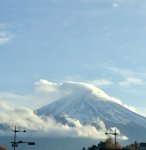lightcycle
Nomad

And then further on, we see the same figures in silhouette on the road. Is this a special thing in Tokushima?
Upon closer inspection, these two figures were everywhere, on store windows, posters, etc.
I looked up "Awa Odori" on the Internet and discovered that Tokushima is the site of an annual music and dance festival, held at the end of every summer.
Legend has it that in the 1500s, a feudal lord sent sake out to all the villagers to celebrate after completing construction of his castle in Tokishima (which back then was called Awa). The villagers all got drunk and started stumbling through the streets in a haphazard fashion.
From then on, every year people danced on the streets in drunken fashion. There's a specific dance movement, which requries raising your right arm and right leg, then your left arm and left leg, exactly like those figurines found all over the city.

The Awa Dance. Not my pictures. Taken from the Internet
These days, hundreds of dancers will take to the streets dressed in colourful costumes. Tens of thousands more come from all over the country and the world, all to take part in the annual drunken dance. Because it's not enough just to spectate. During the dance, everyone chants in Japanese, "It's a fool who dances and a fool who watches! If both are fools, you might as well have fun dancing!" HAHA! So cool!!!
Just like the huge Fire Festival in Kumano, we are slowly finding out that Japan is home to dozens of these crazy festivals held all over the country at various times of the year. We've now made it a mission to see and take part in at least one of these over-the-top festivals during our trip. It's the next item right after Neda's "Cherry Blossom Festival" on our Japan bucket list!
That was an excellent rest day in Tokushima. We're off to explore Shikoku now!





















